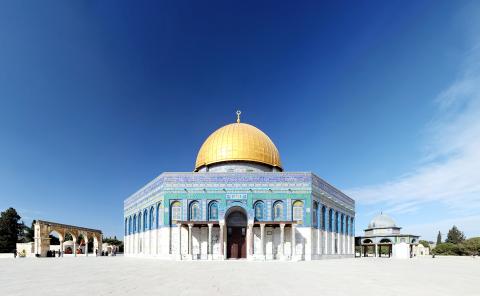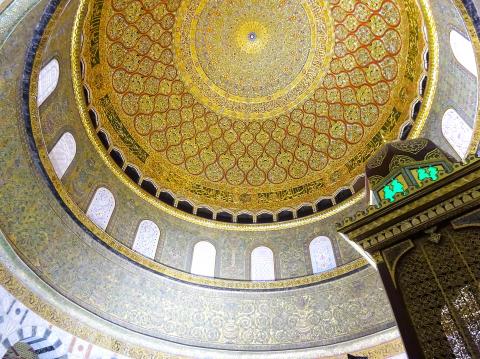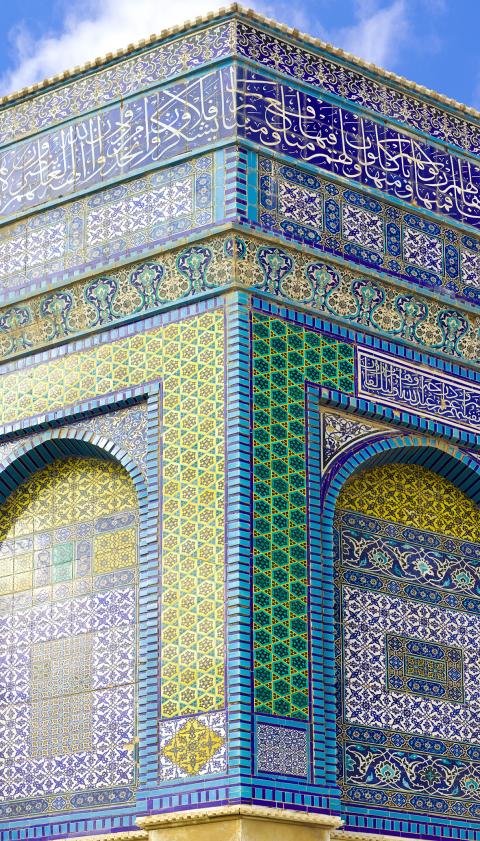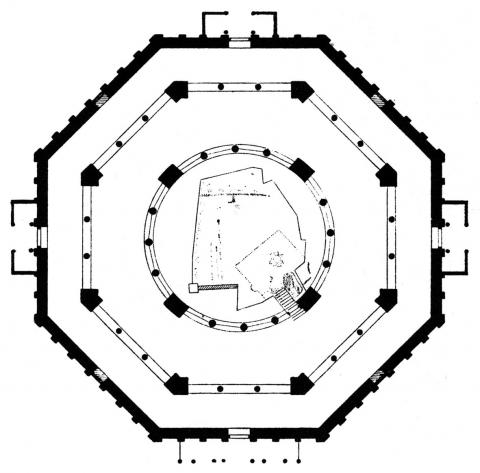According to the Koran, on the night of July 27 in the year 621, the Prophet Mohammed (c. 570-632), responding to a call from Allah, rode on a steed called Buraq from Mecca to the “Farthest Mosque” where Mohammed is said to have been granted an audience with Allah. The famous trip is known as the Night Journey and Ascension to Heaven and is the origin of the Muslim holiday celebrating the Isra and Miraj.
The Dome of the Rock located on the Temple Mount in the Old City of Jerusalem was built between 688 and 692 and is constructed around a large foundation stone which, according to legend, is where Mohammed ascended to heaven.
The Dome of the Rock is the oldest extant work of Islamic architecture and has undergone a number of restorations throughout its more than 1000-year history. During the early days of Islam, the Dome of the Rock’s exterior was not a uniform shape. In fact, its later octagonal construction is thought to have been inspired by a nearby Christian church, so that the Dome of the Rock’s archetypal dome, familiar today, in fact borrows its origins from Byzantine architecture. Furthermore, the minaret which now dominates the skyline next to the Dome of the Rock was not an original feature of the temple.

Photo: Wikimedia Commons
照片:維基共享資源
A unique aspect of the Dome of the Rock’s architecture is that inside the temple there are no statues, portraits or offerings since Islam emphasizes the exclusive worship of Allah and forbids any worship of other idols. For this reason, the interior of the temple is made up only of columns and decoration on the walls and dome, which feature scriptures written in a variety of Arabic calligraphy styles and abstract decorative designs.
The Dome of the Rock’s interior makes use of a large amount of geometric imagery and complex ceremonial floral designs, while repeating, rhythmical visuals abound which give worshippers a feeling of the order and never-ending magnitude of the universe.
(Translated by Edward Jones)

Photo: Wikimedia Commons
照片:維基共享資源
據《古蘭經》記載,先知穆罕默德(生卒年約為西元五七○~六三二年)在西元六二一年七月二十七日(伊斯蘭曆前一年七月十七日)夜晚,應真主之召乘著馬形神獸布拉克由麥加來到遠方一座寺院,直昇天庭晉見真主。這段旅程便是著名的「夜行登霄」,也是伊斯蘭教「登霄節」的由來。
耶路撒冷舊城聖殿山上的「圓頂清真寺」(建成年代為西元六八八~六九二年),圍繞一塊巨岩而築,相傳這塊岩石便是穆罕默德登天之處。
圓頂清真寺是現存最早的伊斯蘭建築之一,一千多年來幾經整建。在伊斯蘭教初始,清真寺的外觀並無既定形式規範。事實上,圓頂清真寺後來的八邊形結構,咸認是參考附近的一間基督教教堂;現今視為清真寺標準元素的穹頂,則是借自於拜占庭建築風格。聳立於清真寺旁天際線的高聳宣禮塔,當時仍尚未出現。

Photo: Wikimedia Commons
照片:維基共享資源
然而,清真寺建築自始即確定的特色是,寺內沒有任何雕像、畫像或供品,因為伊斯蘭教強調應專注禮拜真主,禁止祭拜偶像。因此圓頂清真寺室內只有圍繞的柱廊,牆面及穹頂之裝飾則是用各種阿拉伯書法字體的經文,以及抽象花紋構成。
圓頂清真寺內外牆都運用了大量的幾何圖形及繁複的花草花紋樣式,呈現出重複而有節奏的鋪天蓋地視覺效果,令朝拜者感到宇宙的秩序及無窮盡之感。
(台北時報林俐凱)

Photo: Wikimedia Commons
照片:維基共享資源

Undersea cables are conductors wrapped in insulating materials and laid on the seabed. Their main functions are telecommunications or power transmission. The core of the undersea cables used for Internet signals is optical fiber, using light to transmit Internet signals. Taiwan’s communications are currently handled by 10 domestic undersea cables and 14 international undersea cables. About 99 percent of Taiwan’s Internet bandwidth relies on undersea cables, making them Taiwan’s “digital lifeline.” The demands on the cables’ bandwidth are only set to increase with the development of artificial intelligence (AI), which relies on the data fed into it. Today, data is

Street lights are often taken for granted until a power outage plunges the world into darkness. When that happens, the value of these lighting installations becomes evident as the world turns into a more dangerous place for pedestrians and motorists alike. The Chinese could claim to be the first to have constructed a crude type of street light. Around 500 BC, residents of Beijing employed a type of street lamp that used hollow bamboo pipes and natural gas vents to create burning torches. Later, ancient Romans adopted lamps fueled by vegetable oil, which relied on slaves to light and

Recent events in Taiwan have highlighted the contentious nature of “priority seating” on public transportation. Incidents, such as passengers experiencing emotional distress after being compelled to give up their seats and elderly individuals attacking others after being refused a seat, have prompted a national reassessment of this policy. Some voices in Taiwan now advocate for abolishing priority seats to prevent such conflicts. This issue is not unique to Taiwan. In South Korea, where respect for the elderly is deeply ingrained, priority seating has led to similar confrontations. Younger passengers often face accusations of disrespect if they do not yield seats. In

Spoiler alert and shift blame 破梗&甩鍋 在新冠疫情期間,無論是因為封城 (lockdown) 還是居家隔離 (self-isolation at home),人們關在家中使用網路的時間大增。這也讓一些原本只存在於網路論壇的用語廣為普及。我們來談一下破梗 (spoiler alert) 與甩鍋 (shift blame) 這兩個用語。 有位古典文學教授 Joel Christensen 針對領導統御與疫情控制寫了一篇以古喻今、相當深入的文章:“Plagues follow bad leadership in ancient Greek tales”,文中出現一些講法,可用來翻譯上述的流行語: In the 5th century B.C., the playwright Sophocles begins Oedipus Tyrannos with the title character struggling to identify the cause of a plague striking his city, Thebes. (Spoiler alert: It’s his own bad leadership.) (Joel Christensen, “Plagues follow bad leadership in ancient Greek tales,” The Conversation, March 12, 2020) 作者提到 Oedipus(伊底帕斯)想找出瘟疫何以降臨他的城邦的緣由,加了一句:Spoiler alert: It’s his own bad leadership.(破梗:領導無方)。Spoiler alert 就是「破梗」,如果用在有人洩漏電影劇情的情境中,也可以翻作「小心爆雷」或「劇透警告」。疫情之下,在家看影集、電影成了很多人的娛樂,但要小心劇透 (spoilers),很多 YouTube 上的影評在開頭也都會說 Spoiler alert!,警告還沒看過電影的觀眾小心爆雷、劇透。 至於「甩鍋」,源自大陸網民用語,通常意指某人犯了錯之後想推卸責任、轉移焦點、甚至讓別人背黑鍋的做法。疫情爆發後,相關網路資訊量爆增,許多中國網民也想找人為這場疫情負責,紛紛呼籲地方政府首長、地方黨書記不要「甩鍋」。 其實,在古代文學《奧德賽》中,就有「將自己的責任怪罪眾神」的說法,試用時下流行的「甩鍋」來重新翻譯: Humans are always blaming the gods for their suffering, but they experience